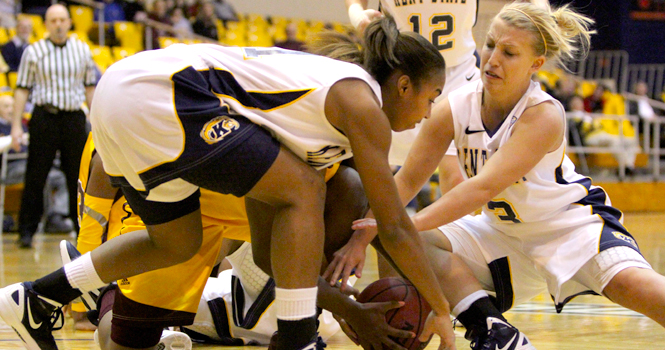Woman’s basketball: Princeton offense equivalent to learning a foreign language
Freshmen Josey Hull and Melanee Stubbs both go after the ball on January 22. The Flashes beat the Chippewas 67 to 64. Photo by Adrianne Bastas.
January 25, 2012
When coach Bob Lindsay lost all five starters last season, he lost more than just players. He lost five teachers to a very complex offense.
Over his coaching tenure, Lindsay has run the Princeton offense as a means of being a duel threat offense. When operating correctly, the Princeton offense uses precision passes in a spread offense to find players cutting to the basket while also allowing shooters to get open on the perimeter.
Lindsay has compared it to teaching a foreign language to his players.
But over the past few games, the Flashes have gotten on a roll with the offense, which can be a nightmare for other Mid-American Conference opponents.
“All your reads offensively are based on another team’s ability to shut your back cuts down,” Lindsay said. “It is a spread offense, and it’s similar to a lot of spreads. Usually it’s a four-out, five-out type of offense. It’s a lot of passing and cutting, a lot of three point shooting and layups.”
Over the past three games in which the Flashes have gone 2-1, almost all of the indications of an efficient Princeton offense are in place. In that stretch, the team is averaging over 71 points per game while the season average is around 57 points.
Another big indicator that the team is on track is the assist totals that are soaring up. Averaging about 13 assists per game, in the last three games the Flashes have averaged close to 20 per game while also shooting a higher percentage from beyond the arch.
The Flashes can only get better with the youth of the team now playing into Lindsay’s hands.
“A passing, cutting offense is only as good as often times as the players running it,” Lindsay said. “And in order to be good regardless of how the players are, you have to have an understanding of what you’re trying to do. We are much better now in terms of understanding the offense. We have got to work really hard on the fundamental things like passing the ball and hitting open shots and making layups.”
Once the Flashes fully grasp the full potential of the offense, opposing defenses will have to make a decision: Do they take away cuts to the basket or stay and guard the perimeter?
“Teams will generally try to either take away your back cuts or take away your three point shots,” Lindsay said. “They’ll do one or the other. They’ll go into a game and try and take something away from you, and you’ve got to be able to adjust what teams are doing and then get your shots based on that.”
Coming into its own at the right time, the Flashes are starting to make an impression on the rest of the MAC with the new success in the scoring column. The “Big Three” of junior forward Diamon Beckford, junior guards Tamzin Barroilhet and Trisha Krewson have shot their averages up.
Beckford is averaging 22.7 points per game while Krewson is adding 15.7 and Barroilhet with 14.3 in the team’s last three games. Their impact is just a taste of what makes the Flashes’ offense click over the last few games.
With a tough MAC West swing coming up, Lindsay is relying on his “Big Three” to continue to score and find open looks.
“You have to cut really hard,” Lindsay said. “Every cut we make has to be for a layup. You read what defenders are doing, whether they are switching or playing soft. The thing that we need to work on is the thing we work on every day: execution, passing skills and then shooting. I don’t care what offense you run. If you can’t shoot it and you can’t pass it, you’re probably not going to be very good.”
Contact Matt Lofgren at at [email protected].






















